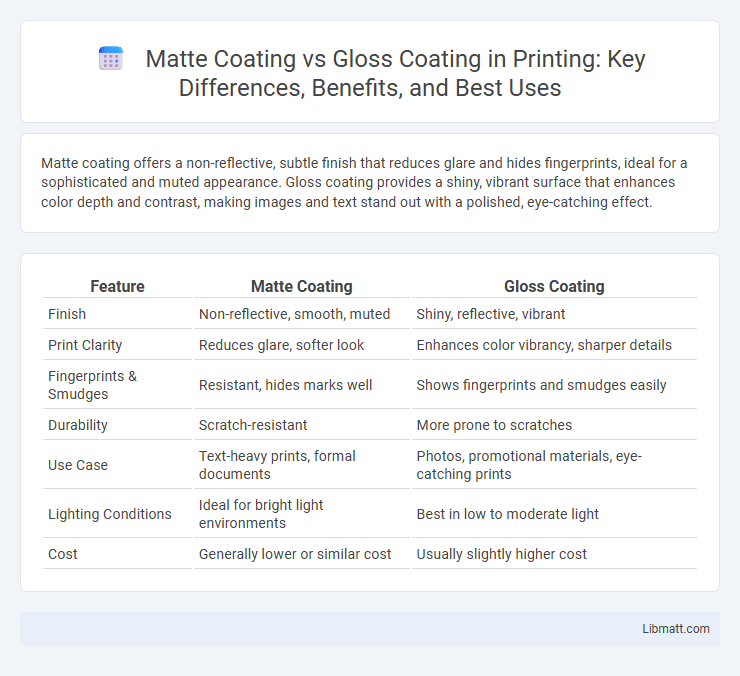Matte coating offers a non-reflective, subtle finish that reduces glare and hides fingerprints, ideal for a sophisticated and muted appearance. Gloss coating provides a shiny, vibrant surface that enhances color depth and contrast, making images and text stand out with a polished, eye-catching effect.
Table of Comparison
| Feature | Matte Coating | Gloss Coating |
|---|---|---|
| Finish | Non-reflective, smooth, muted | Shiny, reflective, vibrant |
| Print Clarity | Reduces glare, softer look | Enhances color vibrancy, sharper details |
| Fingerprints & Smudges | Resistant, hides marks well | Shows fingerprints and smudges easily |
| Durability | Scratch-resistant | More prone to scratches |
| Use Case | Text-heavy prints, formal documents | Photos, promotional materials, eye-catching prints |
| Lighting Conditions | Ideal for bright light environments | Best in low to moderate light |
| Cost | Generally lower or similar cost | Usually slightly higher cost |
Introduction to Matte and Gloss Coatings
Matte coating provides a non-reflective, smooth finish that minimizes glare and fingerprints, making it ideal for elegant, subtle designs and soft visual appeal. Gloss coating offers a shiny, reflective surface that enhances color vibrancy and detail sharpness, perfect for eye-catching prints and high-impact presentations. Your choice between matte and gloss coatings should consider the desired aesthetic effect and functional benefits for the final product.
What Is Matte Coating?
Matte coating is a non-reflective finish applied to printed materials, providing a smooth, dull surface that reduces glare and fingerprints. It enhances color depth and contrast while offering a sophisticated, muted appearance often used for premium prints and packaging. This coating improves durability by protecting against scratches and smudges without the shiny effect of gloss coating.
What Is Gloss Coating?
Gloss coating is a shiny, reflective finish applied to printed materials, enhancing color vibrancy and creating a polished look that makes images and text stand out. This coating type is ideal for marketing materials like brochures and magazines where vivid, eye-catching visuals are crucial. Your documents benefit from increased durability and resistance to fingerprints and smudges, ensuring a professional appearance over time.
Visual Differences: Matte vs Gloss
Matte coating offers a non-reflective, smooth finish that minimizes glare and reduces fingerprints, making text and images easier to read under bright light. Gloss coating creates a shiny, reflective surface that enhances color vibrancy and sharpness, providing a polished, eye-catching appearance. The visual distinction lies in matte's subtle, muted look versus gloss's high-contrast, radiant effect.
Durability and Protection Comparison
Matte coatings offer superior resistance to scratches and fingerprints due to their textured surface, making them ideal for products exposed to frequent handling. Gloss coatings provide a hard, shiny finish that enhances water resistance and UV protection, which helps maintain color vibrancy over time. When choosing between the two, consider how your item's exposure to wear and environmental factors impacts the level of durability and protection required.
Touch and Feel: Texture Contrasts
Matte coating offers a soft, velvety texture that reduces glare and fingerprints, providing a subtle and elegant tactile experience. Gloss coating, in contrast, delivers a smooth, slick surface with a shiny finish that enhances color vibrancy and offers a sleek, polished feel. Your choice between matte and gloss will influence the sensory interaction and perceived quality of the printed material.
Suitability for Different Applications
Matte coating suits applications needing a non-reflective, subtle finish, ideal for art prints, photography, and luxury packaging where glare reduction enhances visual appeal. Gloss coating fits products requiring vibrant color enhancement and high shine, such as brochures, posters, and product labels that demand eye-catching aesthetics. Choosing between matte and gloss depends on balancing desired visual impact with functional needs like readability and durability in various lighting conditions.
Cost Considerations: Matte vs Gloss
Matte coating generally costs less than gloss coating due to simpler production processes and lower material expenses. Gloss coatings require higher-quality resins and additional steps like curing and polishing, increasing overall costs. Understanding these cost differences can help you choose the most budget-friendly finish for your project without compromising quality.
Environmental Impact and Maintenance
Matte coatings typically have a lower environmental impact due to their reduced need for harsh chemicals during cleaning and less frequent reapplication compared to gloss coatings, which can require more intensive polishing products that may contain volatile organic compounds (VOCs). Matte surfaces better hide fingerprints and smudges, meaning Your maintenance routine is less demanding and uses fewer chemical cleaners, supporting eco-friendly practices. Gloss coatings, while visually striking, often necessitate more frequent cleaning with stronger agents that can contribute to environmental pollution.
Choosing the Right Coating: Factors to Consider
Matte coating reduces glare and fingerprints, making it ideal for photography and art prints where detail and texture matter, while gloss coating enhances color vibrancy and sharpness, suitable for marketing materials and photos aiming to stand out. Consider your project's purpose, lighting conditions, and desired aesthetic--matte offers a subtle, sophisticated finish, whereas gloss provides a bold, eye-catching look. Understanding these factors ensures you select the right coating to protect and enhance Your visuals effectively.
matte coating vs gloss coating Infographic

 libmatt.com
libmatt.com